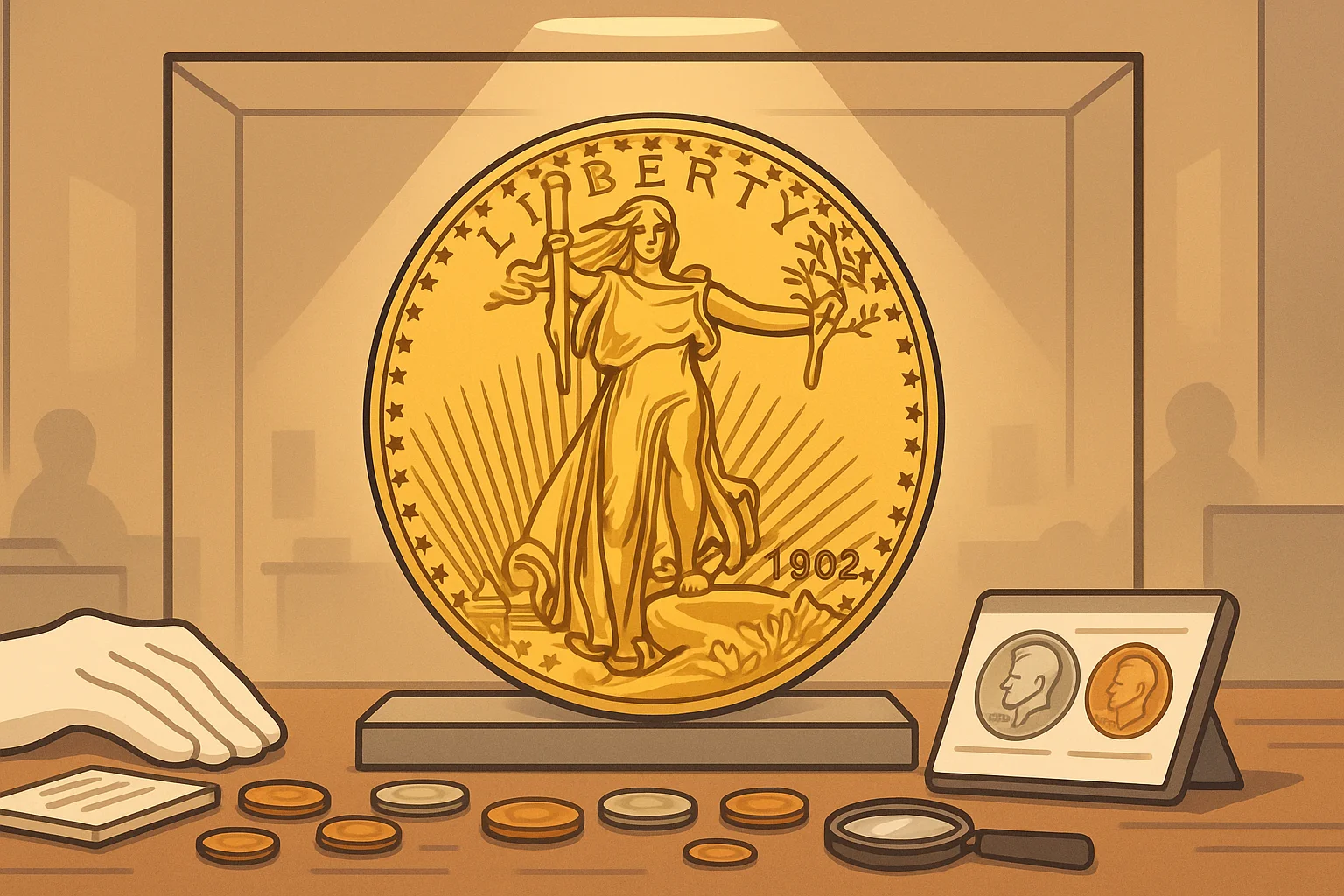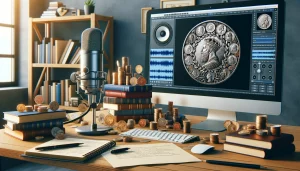The 20th century marked a golden age for American coin design. Sculptors treated coins as miniature works of art, using metal to express national pride and creativity. Сoins likе the 1979 silver dollar defined the finest artistry in U.S. coinage.

1. Susan B. Anthony Dollar (1979–1999)
The Susan B. Anthony dollar is a United States history landmark. This design by Frank Gasparro was the first United States coin to show an existing American woman. It was Susan B. Anthony, a leader in the suffrage movement and symbol of determination and strength.
- Front: A realistic portrait of Anthony. The face conveys strength and determination.
- Reverse: The eagle touchdown on the Moon of Apollo 11, commemorating national achievement and ambition.
Although the coin failed in circulation because of its size, its importance remained. It is a landmark in U.S. coinage design — realistic, current, and symbolic.
Standout variety: The 1979-P Wide Rim type has a closer date and thicker border. It is rare and popular, going readily for $300–$500 in high grades. The Coin ID Scanner app is employed by collectors to check for mint marks and authenticate such varieties in seconds.
2. Walking Liberty Half Dollar (1916–1947)
Walking Liberty Half Dollar is a legend of the 20th century. It is full of movement and delight in every detail. To sum up, it is pure elegant perfection.
Design highlights:
- Obverse: Liberty is wrapped in the American flag, it strides toward sunrise. She bears olive and oak branches, the emblems of peace and power.
- Reverse: An eagle sits on a rock, its wings half-spread, preparing to fly.
This coin represents freedom of mobility and power in balance. It is a masterpiece in luster and good relief in higher uncirculated grades.
Collector focus: Pay attention to dates like 1916-S and 1921-D as they are not common. Uncirculated pieces with MS65 or higher sell for thousands of dollars. Coin ID Scanner is one form of new technology that allows collectors to check mint marks and authenticity before purchasing.
3. Indian Head Cent (1859–1909)
The Indian Head Cent by James B. Longacre combines classic art and American heritage. It became the most enduring small coin of the time.
Design details:
- Obverse: Liberty wears a Native American headdress. It symbolizes national unity and identity.
- Reverse: Plain wreath surrounds the denomination, a federal shield as the border.
Longacre’s skill allowed him to make the engraving also detailed and symmetrical. Both coin’s design and cultural significance expanded from the 19th to 20th centuries.
Collector tip: Look for dates like 1877, 1908-S, and 1909-S. Red Mint State coins can command over $5,000 or more. Collectors can easily and quickly authenticate and detect forgeries with the Coin ID Scanner.
4. Saint-Gaudens Double Eagle (1907–1933)
This one is told to be the most beautiful American coin ever made. It truly revolutionized gold coinage to resemble a work of art. Roosevelt requested U.S. coins to be as stunning as they were in Greek and Roman times. As a result, Saint-Gaudens delivered just that.
Design details
Obverse: Lady Liberty moves forward, an olive branch in her left hand and a torch in her right. Sun rays shine from behind the Capitol dome.
Reverse: A soaring eagle flies above the sunrise surrounded by the motto “In God We Trust.”
The piece is solid, heavy, and gorgeous. Each line, feather, and bend is masterfully sculpted. It is frequently viewed as an expression of America’s self-assurance during the early 1900s, numismatists say.
Collector appeal: The 1907 High Relief variety is a masterpiece of numismatics. Its deep strike required repeated striking, which led to low mintage. Surviving specimens are worth $10,000 to $50,000, while some ultra-high-relief types fetch six figures. The 1933 Double Eagle, never circulated, is one of the world’s most expensive coins, selling for over $18 million in auction.
Collectors today employ the Coin ID Scanner app to view authenticated photos, mint marks, and market value, making identification easier for such valuable coins.
5. Mercury Dime (1916–1945)
The Mercury Dime by Adolph A. Weinman remains a piece of exquisite-scale craftsmanship. Properly named the Winged Liberty Head Dime, it gained this nickname because the cap that Liberty wears resembles the Roman god Mercury. The coin is dynamic, elegant, and iconic.
Design elements
- Obverse: Head of Liberty with small wings on her cap, showing freedom of the mind.
- Reverse: A fasces, showing strength and unity, tied in olive branches for peace.
This combination of strength and beauty makes the Mercury Dime one of America’s most popular coins. Small size does not limit the artist — the fine details are even discernible to a magnifying glass.
Collector insights: Some coins, like the 1916-D, are rare and in high demand. Uncirculated coins can bring $15,000–$20,000. Proofs from the late 1930s also carry premiums for their mirror-like appearance. The Full Bands variety — in which the horizontal bands of the fasces show through in full — carries a premium.
Don’t hesitate to use Coin ID Scanner straight away. It is one of the technologies to verify the details instantly for further correct grading and preventing costly mistakes.

Caring Of 20th-Century Coin Art Today
The artistry of 20th-century coins mesmerizes collectors, historians, and artists for decades. Each of the designs reflects an era’s values and the craftsmanship of the time. These coins even gained importance as time passed. Now it’s time to see how to keep this legacy preserved.
1. Learning the Artistic and Historic Significance
Each coin tells a different story:
- The Susan B. Anthony Dollar honors progress and equality.
- The Walking Liberty Half Dollar whispers of freedom and optimism.
- The Indian Head Cent honors unity in symbolism.
- The Saint-Gaudens Double Eagle keeps national pride in gold.
- The Mercury Dime brings strength and beauty together.
Together, they form a timeline of American values and artistic motivation. Studying them is a history of the way coin design evolved from realism to symbolism, in which ancient inspiration merged with modern ideals.
2. Caring for Artistic Coins
Preserving the integrity of the coins keeps them beautiful and historically valuable. Dirt or rough handling damages fine details beyond repair, so collectors adopt strict preservation methods.
Absolutely essential tips on care:
- Support coins by edges in order to avoid fingerprints.
- Handle high-grade or proof coins using cotton gloves.
- Store in PVC-free archival-quality flips or use airtight holders.
- Keep coins in a low-humidity, cool environment without direct sunlight.
- Never clean the coins not to destroy the original luster and patina with chemicals.
For serious collectors, documenting purchase history, certification data, and provenance increases value and authenticity of each item.
3. Use of New Tools for Identification and Research
Technology allows collectors to follow artistry with more precision. The Coin ID Scanner app, offered for Android and iOS, scans and analyzes coins in seconds.
Practical advantages:
- Detects mint mark, metal composition, and diameter.
- Estimates market value based on real data.
- Determines rare varieties or mint errors automatically.
- Creates a digital catalog for orderly tracking of the collection.
With such resources, collectors can connect visual imagination to technical knowledge, deepening understanding of every design and making sound decisions in the marketplace.
4. Continuing the Legacy
American coinage continues to be infused with the legacy of these masterpieces. Modern issues from the American Eagle series on through the American Women Quarters all echo these same sentiments of freedom, progress, and beauty. Collectors studying early 20th-century coins are always impressed with their artwork and with the stories they tell.
Preserving these coins secures generations to come an opportunity to view the craftsmanship typical of a century. By joining reverence for the past with wise collecting practices, collectors safeguard this heritage — not just as metal, but as living art.
The 20th century truly set the golden age of American coin craftsmanship. Each masterpiece intrigued by its appearance, symbolism, and technical excellence. Careful conservation, ongoing research, and the aid of new technology lets hobbyists treat such rarities and treasures the right way.



